Rosalind Franklin (rover)
Rosalind Franklin,[6] previously known as the ExoMars rover, is a planned robotic Mars rover, part of the international ExoMars programme led by the European Space Agency and the Russian Roscosmos State Corporation.[7][8] The mission was scheduled to launch in July 2020,[9] but was postponed to 2022.[3]
.jpg) ExoMars rover prototype, displayed at the 2009 U.K. National Astronomy Meeting | |
| Mission type | Mars rover |
|---|---|
| Operator | ESA · Roscosmos |
| Website | exploration |
| Mission duration | ≥ 7 months[1] |
| Spacecraft properties | |
| Manufacturer | Astrium · Airbus |
| Launch mass | 310 kg (680 lb) |
| Power | 1,200 W solar array/1142 W·h Lithium-ion[2] |
| Start of mission | |
| Launch date | August–October 2022[3] |
| Rocket | Proton-M/Briz-M[4] |
| Launch site | Baikonur |
| Contractor | Khrunichev |
| Mars rover | |
| Landing date | April–July 2023[5] |
| Landing site | Oxia Planum |
ExoMars programme | |
The plan calls for a Russian launch vehicle, an ESA carrier module, and a Russian lander named Kazachok,[10] that will deploy the rover to Mars' surface.[11] Once it has safely landed, the solar powered rover will begin a seven-month (218-sol) mission to search for the existence of past life on Mars. The Trace Gas Orbiter (TGO), launched in 2016, will operate as the data-relay satellite of Rosalind Franklin and the lander.[12]
The rover is named after Rosalind Franklin, an English chemist and DNA pioneer.
History
Design
The Rosalind Franklin rover is an autonomous six-wheeled terrain vehicle with mass approximately 300 kg (660 lb), about 60% more than NASA's 2004 Mars Exploration Rovers Spirit and Opportunity,[13] but about one third that of NASA's Curiosity rover launched in 2011. ESA returned to this original Rover design after NASA descoped its involvement in a joint Rover mission, studied 2009-2012.
The Rover will carry a 2-metre (6 ft 7 in) sub-surface sampling drill and Analytical Laboratory Drawer (ALD), supporting the nine 'Pasteur payload' science instruments. The Rover will search for biomolecules or biosignatures from past life.[14][1][15][16][17]
Construction
The lead builder of the rover, the British division of Airbus Defence and Space, began procuring critical components in March 2014.[18] In December 2014, ESA member states approved the funding for the rover, to be sent on the second launch in 2018,[19] but insufficient funds had already started to threaten a launch delay until 2020.[20] The wheels and suspension system were paid for by the Canadian Space Agency and were manufactured by MDA Corporation in Canada.[18] Each wheel is 25 cm (9.8 in) in diameter.[21] Roscosmos will provide radioisotope heater units (RHU) for the rover to keep its electronic components warm at night.[7][22] The rover was assembled by Airbus DS in the UK during 2018 and 2019.[23]
Launch schedule
By March 2013, the spacecraft was scheduled to launch in 2018 with a Mars landing in early 2019.[11] Delays in European and Russian industrial activities and deliveries of scientific payloads forced the launch to be pushed back. In May 2016, ESA announced that the mission had been moved to the next available launch window of July 2020.[9] ESA ministerial meetings in December 2016 reviewed mission issues including €300 million ExoMars funding and lessons learned from the ExoMars 2016 Schiaparelli mission, which had crashed after its atmospheric entry and parachute descent (the 2020 mission drawing on Schiaparelli heritage for elements of its entry, descent and landing systems).[24] In March 2020, ESA delayed the launch to August–October 2022 due to parachute testing issues.[3]
Naming
In July 2018, the European Space Agency launched a public outreach campaign to choose a name for the rover.[25] On 7 February 2019, the ExoMars rover was named Rosalind Franklin in honour of scientist Rosalind Franklin (1920-1958),[26] who made key contributions to the understanding of the molecular structures of DNA (deoxyribonucleic acid), RNA (ribonucleic acid), viruses, coal, and graphite.[27]
Navigation
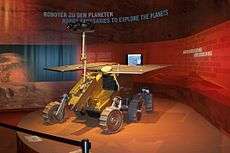
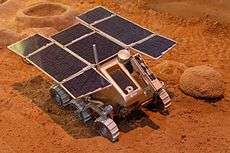
The ExoMars mission requires the rover to be capable of driving across the Martian terrain at 70 m (230 ft) per sol (Martian day) to enable it to meet its science objectives.[28][29] The rover is designed to operate for at least seven months and drive 4 km (2.5 mi), after landing.[18]
Since the rover communicates with the ground controllers via the ExoMars Trace Gas Orbiter (TGO), and the orbiter only passes over the rover approximately twice per sol, the ground controllers will not be able to actively guide the rover across the surface. The Rosalind Franklin rover is therefore designed to navigate autonomously across the Martian surface.[30][31] Two stereo camera pairs (NavCam and LocCam) allow the rover to build up a 3D map of the terrain,[32] which the navigation software then uses to assess the terrain around the rover so that it avoids obstacles and finds an efficient route to the ground controller specified destination.
On 27 March 2014, a "Mars Yard" was opened at Airbus Defence and Space in Stevenage, UK, to facilitate the development and testing of the rover's autonomous navigation system. The yard is 30 by 13 m (98 by 43 ft) and contains 300 tonnes (330 short tons; 300 long tons) of sand and rocks designed to mimic the terrain of the Martian environment.[33][34]
Pasteur Payload
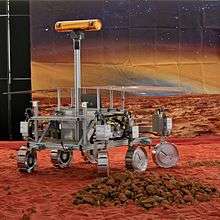
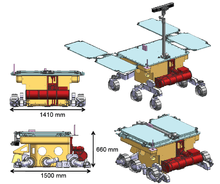
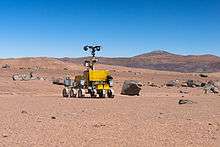
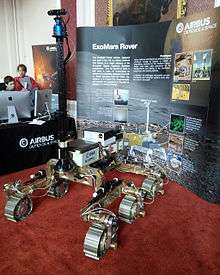
The rover will search for two types of subsurface life signatures, morphological and chemical. It will not analyse atmospheric samples,[35] and it has no dedicated meteorological station,[36] but the Kazachok lander that will deploy the rover is equipped with a meteorological station. The 26 kg (57 lb)[1] scientific payload comprises the following survey and analytical instruments:[7]
Panoramic Camera (PanCam)
PanCam has been designed to perform digital terrain mapping for the rover and to search for morphological signatures of past biological activity preserved on the texture of surface rocks.[37] The PanCam Optical Bench (OB) mounted on the Rover mast includes two wide angle cameras (WACs) for multi-spectral stereoscopic panoramic imaging, and a high resolution camera (HRC) for high-resolution colour imaging.[38][39] PanCam will also support the scientific measurements of other instruments by taking high-resolution images of locations that are difficult to access, such as craters or rock walls, and by supporting the selection of the best sites to carry out exobiology studies. In addition to the OB, PanCam includes a calibration target (PCT), Fiducial Markers (FidMs) and Rover Inspection Mirror (RIM). The PCT's stained glass calibration targets will provide a UV-stable reflectance and colour reference for PanCam and ISEM, allowing for the generation of calibrated data products.[37][40]
Infrared Spectrometer for ExoMars (ISEM)
The ISEM[41][42] optical box will be installed on the rover's mast, below PanCam's HRC, with an electronics box inside the Rover. It will be used to assess bulk mineralogy characterization and remote identification of water-related minerals. Working with PanCam, ISEM will contribute to the selection of suitable samples for further analysis by the other instruments.
Water Ice Subsurface Deposits Observation on Mars (WISDOM)
WISDOM is a ground-penetrating radar that will explore the subsurface of Mars to identify layering and help select interesting buried formations from which to collect samples for analysis.[43][44] It can transmit and receive signals using two Vivaldi-antennas mounted on the aft section of the rover, with electronics inside the Rover. Electromagnetic waves penetrating into the ground are reflected at places where there is a sudden transition in the electrical parameters of the soil. By studying these reflections it is possible to construct a stratigraphic map of the subsurface and identify underground targets down to 2 to 3 m (7 to 10 ft) in depth, comparable to the 2 m reach of the rover's drill. These data, combined with those produced by the other survey instruments and by the analyses carried out on previously collected samples, will be used to support drilling activities.[45]
Adron-RM
Adron-RM is a neutron spectrometer to search for subsurface water ice and hydrated minerals.[41][42][46][47] It is housed inside the Rover and will be used in combination with the WISDOM ground-penetrating radar to study the subsurface beneath the rover and to search for optimal sites for drilling and sample collection.
Close-Up Imager (CLUPI)
CLUPI, mounted on the drill box, will visually study rock targets at close range (50 cm/20 in) with sub-millimetre resolution. This instrument will also investigate the fines produced during drilling operations, and image samples collected by the drill. CLUPI has variable focusing and can obtain high-resolution images at longer distances.[7][41] The CLUPI imaging unit is complemented by two mirrors and a calibration target.
Mars Multispectral Imager for Subsurface Studies (Ma_MISS)
Ma_MISS is an infrared spectrometer located inside the core drill.[48] Ma_MISS will observe the lateral wall of the borehole created by the drill to study the subsurface stratigraphy, to understand the distribution and state of water-related minerals, and to characterise the geophysical environment. The analyses of unexposed material by Ma_MISS, together with data obtained with the spectrometers located inside the rover, will be crucial for the unambiguous interpretation of the original conditions of Martian rock formation.[7][49] The composition of the regolith and crustal rocks provides important information about the geologic evolution of the near-surface crust, the evolution of the atmosphere and climate, and the existence of past life.
MicrOmega
MicrOmega is an infrared hyperspectral microscope housed within the Rover's ALD that can analyse the powder material derived from crushing samples collected by the core drill.[7][50] Its objective is to study mineral grain assemblages in detail to try to unravel their geological origin, structure, and composition. These data will be vital for interpreting past and present geological processes and environments on Mars. Because MicrOmega is an imaging instrument, it can also be used to identify grains that are particularly interesting, and assign them as targets for Raman and MOMA-LDMS observations.
Raman Laser Spectrometer (RLS)
RLS is a Raman spectrometer housed within the ALD that will provide geological and mineralogical context information complementary to that obtained by MicrOmega. It is a very fast and useful technique employed to identify mineral phases produced by water-related processes.[51][52][53] It will help to identify organic compounds and search for life by identifying the mineral products and indicators of biologic activities (biosignatures).
Mars Organic Molecule Analyzer (MOMA)
MOMA is the rover's largest instrument, housed within the ALD. It will conduct a broad-range, very-high sensitivity search for organic molecules in the collected sample. It includes two different ways for extracting organics: laser desorption and thermal volatilisation, followed by separation using four GC-MS columns. The identification of the evolved organic molecules is performed with an ion trap mass spectrometer.[7] The Max Planck Institute for Solar System Research is leading the development. International partners include NASA.[54] The mass spectrometer is provided from the Goddard Space Flight Center, while the GC is provided by the two French institutes LISA and LATMOS. The UV-Laser is being developed by the Laser Zentrum Hannover.[55]
Payload Support Functions
Sampling from beneath the martian surface with the intent to reach and analyze material unaltered or minimally affected by cosmic radiation is the strongest advantage of Rosalind Franklin. The ExoMars core drill was fabricated in Italy with heritage from the earlier DeeDri development, and incorporates the Ma_MISS instrument (see above).[56] It is designed to acquire soil samples down to a maximum depth of 2 metres (6 ft 7 in) in a variety of soil types. The drill will acquire a core sample 1 cm (0.4 in) in diameter by 3 cm (1.2 in) in length, extract it and deliver it to the Sample Container of the ALD's Core Sample Transport Mechanism (CSTM). The CSTM drawer is then closed and the sample dropped into a Crushing Station. The resulting powder is fed by a dosing station into receptacles on the ALD's sample carousel: either the Refillable Container - for examination by MicrOmega, RLS and MOMA-LDMS - or a MOMA-GC oven. The system will complete experiment cycles and at least two vertical surveys down to 2 m (with four sample acquisitions each). This means that a minimum number of 17 samples shall be acquired and delivered by the drill for subsequent analysis.[57][58]
De-scoped instruments
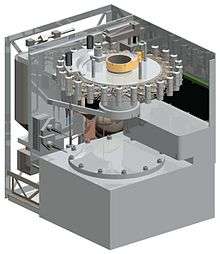
The proposed payload has changed several times. The last major change was after the program switched from the larger rover concept back to the previous 300 kg (660 lb) rover design in 2012.[41]
- Mars X-Ray Diffractometer (Mars-XRD) - Powder diffraction of X-rays would have determined the composition of crystalline minerals.[59][60] This instrument includes also an X-ray fluorescence capability that can provide useful atomic composition information.[61] The identification of concentrations of carbonates, sulphides or other aqueous minerals may be indicative of a Martian [hydrothermal] system capable of preserving traces of life. In other words, it would have examined the past Martian environmental conditions, and more specifically the identification of conditions related to life.[41]
- The Urey instrument was planned to search for organic compounds in Martian rocks and soils as evidence for past life and/or prebiotic chemistry. Starting with a hot water extraction, only soluble compounds are left for further analysis. Sublimation, and capillary electrophoresis makes it possible to identify amino acids. The detection would have been done by laser-induced fluorescence, a highly sensitive technique, capable of parts-per-trillion sensitivity. These measurements were to be made at a thousand times greater sensitivity than the Viking GCMS experiment.[41][62][63]
- Miniaturised Mössbauer Spectrometer (MIMOS-II) provides the mineralogical composition of iron-bearing surface rocks, sediments and soils. Their identification was to aid in understanding water and climate evolution and search for biomediated iron-sulfides and magnetites, which could provide evidence for former life on Mars.
- The Life Marker Chip (LMC) was for some time part of the planned payload. This instrument was intended to use a surfactant solution to extract organic matter from samples of martian rock and soil, then detect the presence of specific organic compounds using an antibody-based assay.[64][65][66]
- Mars Infrared Mapper (MIMA), a Fourier IR spectrometer operating in the 2-25 µm range that was to be mounted on the rover's mast to investigate the martian surface and atmosphere.[67]
Landing site selection
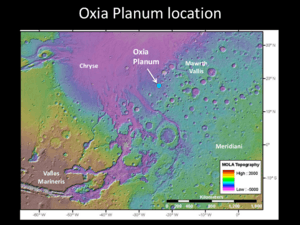
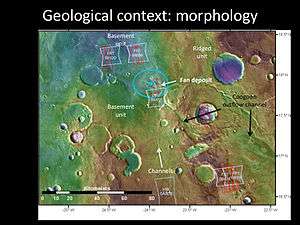
After a review by an ESA-appointed panel, a short list of four sites was formally recommended in October 2014 for further detailed analysis.[68][69] These landing sites exhibit evidence of a complex aqueous history in the past.[47]
- Mawrth Vallis
- Oxia Planum
- Hypanis Vallis
- Aram Dorsum
On 21 October 2015, Oxia Planum was chosen as the preferred landing site for the rover, with Aram Dorsum and Mawrth Vallis as backup options.[47][70] In March 2017 the Landing Site Selection Working Group narrowed the choice to Oxia Planum and Mawrth Vallis,[71] and in November 2018, Oxia Planum was once again chosen, pending sign-off by the heads of the European and Russian space agencies.[72]
After Kazachok lands, it will extend a ramp to deploy the Rosalind Franklin rover to the surface. The lander will remain stationary and will start a two-year mission[73] to investigate the surface environment at the landing site.[74]
See also
- Astrobiology – Science concerned with life in the universe
- Life on Mars – Scientific assessments on the microbial habitability of Mars
- List of missions to Mars – Wikipedia list article
- Mars 2020 – 2020 astrobiology Mars rover mission by NASA
- Timeline of Solar System exploration
References
- Vago, Jorge L.; et al. (July 2017). "Habitability on Early Mars and the Search for Biosignatures with the ExoMars Rover". Astrobiology. 17 (6–7): 471–510. Bibcode:2017AsBio..17..471V. doi:10.1089/ast.2016.1533. PMC 5685153. PMID 31067287.
- "Saft Li-ion Battery to Power the ExoMars Rover as it Searches for Life on the Red Planet". Saft Batteries (Press release). Business Wire. 8 July 2015. Retrieved 8 July 2015.
- "N° 6–2020: ExoMars to take off for the Red Planet in 2022" (Press release). ESA. 12 March 2020. Retrieved 12 March 2020.
- Krebs, Gunter. "ExoMars". Gunter's Space Page. Retrieved 12 March 2020.
- @ESA_ExoMars (12 March 2020). "#ExoMars to take off for the Red Planet in 2022. Check out the new timeline for mission success on the Red Planet! pbs.twimg.com/media/ES52icEX0AELyns?format=jpg" (Tweet). Retrieved 13 March 2020 – via Twitter.
- Amos, Jonathan (7 February 2019). "Rosalind Franklin: Mars rover named after DNA pioneer". BBC News. Retrieved 7 February 2019.
- Vago, Jorge; Witasse, Olivier; Baglioni, Pietro; Haldemann, Albert; Gianfiglio, Giacinto; et al. (August 2013). "ExoMars: ESA's Next Step in Mars Exploration" (PDF). Bulletin. European Space Agency (155): 12–23.
- Katz, Gregory (27 March 2014). "2018 mission: Mars rover prototype unveiled in UK". Excite.com. Associated Press. Retrieved 29 March 2014.
- "Second ExoMars mission moves to next launch opportunity in 2020" (Press release). European Space Agency. 2 May 2016. Retrieved 2 May 2016.
- Wall, Mike (21 March 2019). "Meet 'Kazachok': Landing Platform for ExoMars Rover Gets a Name - In 2021, Rosalind Franklin will roll off Kazachok onto the red dirt of Mars". Space.com. Retrieved 21 March 2019.
- "Russia and Europe Team Up for Mars Missions". Space.com. 14 March 2013. Retrieved 24 January 2016.
- de Selding, Peter B. (26 September 2012). "U.S., Europe Won't Go It Alone in Mars Exploration". Space News. Retrieved 5 January 2014.
- Vego, J. L.; et al. (2009). ExoMars Status (PDF). 20th Mars Exploration Program Analysis Group Meeting. 3–4 March 2009. Arlington, Virginia. European Space Agency. Archived from the original (PDF) on 9 April 2009. Retrieved 15 November 2009.
- "Rover surface operations". European Space Agency. 18 December 2012. Retrieved 16 March 2012.
- "Press Info: ExoMars Status" (Press release). Thales Group. 8 May 2012. Archived from the original on 3 December 2013. Retrieved 8 May 2012.
- "The ExoMars Instruments". European Space Agency. 1 February 2008. Archived from the original on 26 October 2012. Retrieved 8 May 2012.
- Amos, Jonathan (15 March 2012). "Europe still keen on Mars missions". BBC News. Retrieved 16 March 2012.
- Clark, Stephen (3 March 2014). "Facing funding gap, ExoMars rover is on schedule for now". Spaceflight Now. Retrieved 3 March 2014.
- "Europe Agrees to Fund Ariane 6 Orbital Launcher". ABC News. Berlin, Germany. Associated Press. 2 December 2014. Retrieved 2 December 2014.
ESA's member states also approved funding to upgrade the smaller Vega launch vehicle, continue participating in the International Space Station, and proceed with the second part of its ExoMars mission.
- "Money Troubles May Delay Europe-Russia Mars Mission". Industry Week. Agence France-Presse. 15 January 2016. Retrieved 16 January 2016.
- ESA Prepares for ExoMars Rover 2020 Launch at Mars and on Earth. Emily Lakdawalla, The Planetary Society. 30 May 2019.
- Zak, Anatoly (28 July 2016). "ExoMars-2016 mission". Russianspaceweb.com. Retrieved 15 May 2018.
In 2018, a Russian-built radioactive heat generator would be installed on the ExoMars rover, along with possible suit of Russian instruments.
- ExoMars rover leaves British factory, heads for testing in France
- Clery, Daniel (25 October 2016). "Mars lander crash complicates follow-up rover in 2020". Science. doi:10.1126/science.aal0303. Retrieved 4 November 2016.
- Reints, Renae (20 July 2018). "Want to Name the Next European Mars Rover? Here's Your Chance". Fortune. Retrieved 20 July 2018.
- "Name of British built Mars rover revealed". GOV.UK. Retrieved 7 February 2019.
- "The Rosalind Franklin Papers, The Holes in Coal: Research at BCURA and in Paris, 1942–1951". profiles.nlm.nih.gov. Retrieved 13 November 2011.
- Lancaster, R.; Silva, N.; Davies, A.; Clemmet, J. (2011). ExoMars Rover GNC Design and Development. 8th Int'l ESA Conference on Guidance & Navigation Control Systems. 5–10 June 2011. Carlsbad, Czech Republic.
- Silva, Nuno; Lancaster, Richard; Clemmet, Jim (2013). ExoMars Rover Vehicle Mobility Functional Architecture and Key Design Drivers (PDF). 12th Symposium on Advanced Space Technologies in Robotics and Automation. 15–17 May 2013. Noordwijk, the Netherlands. European Space Agency.
- Amos, Jonathan (5 September 2011). "Smart UK navigation system for Mars rover". BBC News.
- "Mars rover Bruno goes it alone". EADS Astrium. 14 September 2011.
- McManamon, Kevin; Lancaster, Richard; Silva, Nuno (2013). ExoMars Rover Vehicle Perception System Architecture and Test Results (PDF). 12th Symposium on Advanced Space Technologies in Robotics and Automation. 15–17 May 2013. Noordwijk, the Netherlands. European Space Agency.
- Amos, Jonathan (27 March 2014). "'Mars yard' to test European rover". BBC News. Retrieved 29 March 2014.
- Bauer, Markus (27 March 2014). "Mars yard ready for Red Planet rover". European Space Agency. Retrieved 29 March 2014.
- "The enigma of methane on Mars". European Space Agency. 2 May 2016. Retrieved 13 January 2018.
- Korablev, Oleg I.; et al. (July 2017). "Infrared Spectrometer for ExoMars: A Mast-Mounted Instrument for the Rover" (PDF). Astrobiology. 17 (6–7): 542–564. Bibcode:2017AsBio..17..542K. doi:10.1089/ast.2016.1543. PMID 28731817.
- Coates, A. J.; et al. (July 2017). "The PanCam Instrument for the ExoMars Rover". Astrobiology. 17 (6–7): 511–541. Bibcode:2017AsBio..17..511C. doi:10.1089/ast.2016.1548.
- "The ExoMars Rover Instrument Suite: PanCam - the Panoramic Camera". European Space Agency. 3 April 2013.
- Griffiths, A. D.; Coates, A. J.; Jaumann, R.; Michaelis, H.; Paar, G.; Barnes, D.; Josset, J.-L.; Pancam Team (2006). "Context for the ESA ExoMars rover: the Panoramic Camera (PanCam) instrument" (PDF). International Journal of Astrobiology. 5 (3): 269–275. Bibcode:2006IJAsB...5..269G. doi:10.1017/S1473550406003387.
- "ExoMars Hardware". Aberystwyth University. Retrieved 16 July 2018.
- "Inside ExoMars". European Space Agency. August 2012. Retrieved 4 August 2012.
- "ExoMars 2018 mission". Институт Космических Исследований Space Research Institute. Retrieved 15 March 2016.
- Corbel, C.; Hamram, S.; Ney, R.; Plettemeier, D.; Dolon, F.; Jeangeot, A.; Ciarletti, V.; Berthelier, J. (December 2006). "WISDOM: An UHF GPR on the Exomars Mission". Proceedings of the American Geophysical Union, Fall Meeting 2006. 51: 1218. Bibcode:2006AGUFM.P51D1218C. P51D–1218.
- Ciarletti, Valérie; et al. (July 2017). "The WISDOM Radar: Unveiling the Subsurface Beneath the ExoMars Rover and Identifying the Best Locations for Drilling". Astrobiology. 17 (6–7): 565–584. Bibcode:2017AsBio..17..565C. doi:10.1089/ast.2016.1532.
- "The ExoMars Rover Instrument Suite: WISDOM - Water Ice and Subsurface Deposit Observation on Mars". European Space Agency. 3 April 2013.
- "The ExoMars Project". RussianSpaceWeb.com. Retrieved 22 October 2013.
- Mitrofanov, I. G.; et al. (July 2017). "The ADRON-RM Instrument Onboard the ExoMars Rover". Astrobiology. 17 (6–7): 585–594. Bibcode:2017AsBio..17..585M. doi:10.1089/ast.2016.1566. PMID 28731818.
- De Sanctis, Maria Cristina; et al. (July 2017). "Ma_MISS on ExoMars: Mineralogical Characterization of the Martian Subsurface". Astrobiology. 17 (6–7): 612–620. Bibcode:2017AsBio..17..612D. doi:10.1089/ast.2016.1541.
- "The ExoMars Rover Instrument Suite: Ma_MISS - Mars Multispectral Imager for Subsurface Studies". European Space Agency. 3 April 2013.
- Korablev, Oleg I.; et al. (July 2017). "Infrared Spectrometer for ExoMars: A Mast-Mounted Instrument for the Rover" (PDF). Astrobiology. 17 (6–7): 542–564. Bibcode:2017AsBio..17..542K. doi:10.1089/ast.2016.1543. PMID 28731817.
- "The ExoMars Rover Instrument Suite: RLS - Raman Spectrometer". European Space Agency. 3 April 2013.
- Popp, J.; Schmitt, M. (2006). "Raman spectroscopy breaking terrestrial barriers!". Journal of Raman Spectroscopy. 35 (6): 18–21. Bibcode:2004JRSp...35..429P. doi:10.1002/jrs.1198.
- Rull Pérez, Fernando; Martinez-Frias, Jesus (2006). "Raman spectroscopy goes to Mars" (PDF). Spectroscopy Europe. 18 (1): 18–21.
- Clark, Stephen (21 November 2012). "European states accept Russia as ExoMars partner". Spaceflight Now.
- Goesmann, Fred; Brinckerhoff, William B.; Raulin, François; Goetz, Walter; Danell, Ryan M.; Getty, Stephanie A.; Siljeström, Sandra; Mißbach, Helge; Steininger, Harald; Arevalo, Ricardo D.; Buch, Arnaud; Freissinet, Caroline; Grubisic, Andrej; Meierhenrich, Uwe J.; Pinnick, Veronica T.; Stalport, Fabien; Szopa, Cyril; Vago, Jorge L.; Lindner, Robert; Schulte, Mitchell D.; Brucato, John Robert; Glavin, Daniel P.; Grand, Noel; Li, Xiang; Van Amerom, Friso H. W.; The Moma Science Team (2017). "The Mars Organic Molecule Analyzer (MOMA) Instrument: Characterization of Organic Material in Martian Sediments". Astrobiology. 17 (6–7): 655–685. Bibcode:2017AsBio..17..655G. doi:10.1089/ast.2016.1551. PMC 5685156. PMID 31067288.
- Coradini, A.; et al. (January 2001). "Ma_MISS: Mars Multispectral Imager for Subsurface Studies" (PDF). Advances in Space Research. 28 (8): 1203–1208. Bibcode:2001AdSpR..28.1203C. doi:10.1016/S0273-1177(01)00283-6.
- "The ExoMars drill unit". European Space Agency. 13 July 2012.
- "Sample Preparation and Distribution System (SPDS)". European Space Agency. 6 February 2013.
- Wielders, Arno; Delhez, Rob (June 2005). "X-ray Powder Diffraction on the Red Planet" (PDF). International Union of Crystallography Commission on Powder Diffraction Newsletter (30): 6–7.
- Delhez, Rob; Marinangeli, Lucia; van der Gaast, Sjerry (June 2005). "Mars-XRD: the X-ray Diffractometer for Rock and Soil Analysis on Mars in 2011" (PDF). International Union of Crystallography Commission on Powder Diffraction Newsletter (30): 7–10.
- "The ExoMars Rover Instrument Suite: Mars-XRD diffractometer". European Space Agency. 1 December 2011.
- Skelley, Alison M.; Scherer, James R.; Aubrey, Andrew D.; Grover, William H.; Ivester, Robin H. C.; et al. (January 2005). "Development and evaluation of a microdevice for amino acid biomarker detection and analysis on Mars". Proceedings of the National Academy of Sciences. 102 (4): 1041–1046. Bibcode:2005PNAS..102.1041S. doi:10.1073/pnas.0406798102. PMC 545824. PMID 15657130.
- Aubrey, Andrew D.; Chalmers, John H.; Bada, Jeffrey L.; Grunthaner, Frank J.; Amashukeli, Xenia; et al. (June 2008). "The Urey Instrument: An Advanced In Situ Organic and Oxidant Detector for Mars Exploration". Astrobiology. 8 (3): 583–595. Bibcode:2008AsBio...8..583K. doi:10.1089/ast.2007.0169. PMID 18680409.
- Leinse, A.; Leeuwis, H.; Prak, A.; Heideman, R. G.; Borst, A. The life marker chip for the Exomars mission. 2011 ICO International Conference on Information Photonics. 18–20 May 2011. Ottawa, Ontario. pp. 1–2. doi:10.1109/ICO-IP.2011.5953740. ISBN 978-1-61284-315-5.
- Martins, Zita (2011). "In situ biomarkers and the Life Marker Chip". Astronomy & Geophysics. 52 (1): 1.34–1.35. Bibcode:2011A&G....52a..34M. doi:10.1111/j.1468-4004.2011.52134.x.
- Sims, Mark R.; Cullen, David C.; Rix, Catherine S.; Buckley, Alan; Derveni, Mariliza; et al. (November 2012). "Development status of the life marker chip instrument for ExoMars". Planetary and Space Science. 72 (1): 129–137. Bibcode:2012P&SS...72..129S. doi:10.1016/j.pss.2012.04.007.
- Bellucci, G.; Saggin, B.; Fonti, S.; et al. (2007). "MIMA, a miniaturized Fourier infrared spectrometer for Mars ground exploration: Part I. Concept and expected performance". In Meynart, Roland; Neeck, Steven P.; Shimoda, Haruhisa; Habib, Shahid (eds.). Sensors, Systems, and Next-Generation Satellites XI. Sensors. 6744. pp. 67441Q. Bibcode:2007SPIE.6744E..1QB. doi:10.1117/12.737896.
- Bauer, Markus; Vago, Jorge (1 October 2014). "Four candidate landing sites for ExoMars 2018". European Space Agency. Retrieved 20 April 2017.
- "Recommendation for the Narrowing of ExoMars 2018 Landing Sites". European Space Agency. 1 October 2014. Retrieved 1 October 2014.
- Atkinson, Nancy (21 October 2015). "Scientists Want ExoMars Rover to Land at Oxia Planum". Universe Today. Retrieved 22 October 2015.
- Bauer, Markus; Vago, Jorge (28 March 2017). "Final two ExoMars landing sites chosen". European Space Agency. Retrieved 8 September 2018.
- Amos, Jonathan (9 November 2018). "ExoMars: Life-detecting robot to be sent to Oxia Planum". BBC News. Retrieved 12 March 2020.
- ExoMars-2020 Surface Platform scientific investigation. Daniel Rodionov, Lev Zelenyi, Oleg Korablev, Ilya Chuldov and Jorge Vago. EPSC Abstracts. Vol. 12, EPSC2018-732, European Planetary Science Congress 2018.
- "Exomars 2018 surface platform". European Space Agency. Retrieved 14 March 2016.
External links
| Wikimedia Commons has media related to ExoMars rover. |
- ExoMars rover at ESA.int
- ExoMars rover at CNES.fr
- ExoMars rover at NASA.gov
- Searching for Signs of Life on Mars on YouTube by NASA/Goddard
.jpg)
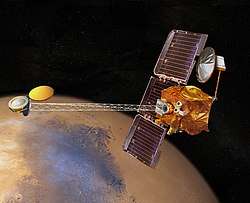
.jpg)
.jpg)
